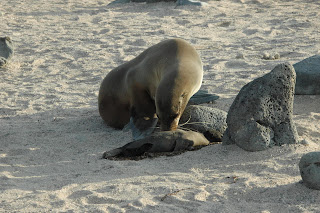
North Seymour Island in the Galapagos Archipelago is a very special place. Few islands exemplify the beauty, mystery, and struggle for life as plainly as this tiny island in the central part of the archipelago. In fact, anyone with a curiosity for the natural sciences would find North Seymour Island fascinating. Its wildlife, both in life and in death, are right there, in close proximity, for interaction and observation.
Personally, North Seymour is especially important. Eight years ago, it was the first of the Galapagos Islands that I ever visited. Whenever I return to North Seymour, I remember the sense of excitement and wonderment that I felt during my first moments in the Galapagos.
In July 2007, I returned to North Seymour after a year's absence. And what a difference a year makes!
Last July, North Seymour Island was very quiet. The blue-footed booby colony utterly failed. And, without adult boobies flying back and forth with food for their chicks, pirating frigatebirds had fewer opportunities to feed their own young. The result resembled mass murder: the scraggly and leafless trees were littered with the drooping and decaying bodies of frigatebird chicks. With very few boobies and a failing frigatebird colony the skies were relatively free from the usual chaos above North Seymour Island.

Avian communities were not alone in their suffering. The beautiful white sands around the southern perimeter of the island were dotted with the carcasses of dead sea lion pups. I remember one instance in particular; I witnessed a mother sea lion returning from an extended fishing expedition. I watched her as she rushed from the ocean, up the sandy beach towards her motionless pup. She called for her pup as all sea lion mothers call for their pups. When she was within touching distance, she bent down and gently nudged her pup with her nose - trying in vain to get a response. This continued for a few minutes. Then, at some moment, she realized her pup was dead and her calls turned from an excited reunion call to a mournful cry. Only the most hardened and blind behavioralist would continue unabashedly to argue that sea lions do not have emotions. In fact, a couple of the children traveling in my group, who witnessed this event, began crying. Obviously, the sympathy of loss transcends mammalian species.

But that was last year. This year North Seymour is abound with activity and life. Blue-footed booby males are dancing and whistling and proudly showing-off their brightly colored feet. Booby nests, which are abundant, contain small naked chicks, older fluffy chicks, and in many cases two chicks (a tell-tale sign of a good year). Additionally, the monotonous earthy tones of North Seymour are punctuated and decorated by bright red balloons - the inflated throat-pouches of breeding male frigatebirds. And, the skies are chaotic once again with swirling and swarming birds. Sea lion pups are fat and giant land iguanas are crawling over the sand and climbing in the trees.

So, what a difference a year makes! ...but what is this difference? In short, it is the food supply beneath the ocean waters. Last year, the ocean temperature bathing the Galapagos archipelago was warmer than average. Consequently, there were fewer nutrients being turned up by cooler, denser waters. With fewer nutrients, there were fewer plankton, fewer plankton means fewer small fish, and so it goes on up the food chain. In contrast, the ocean water is quite cold this year and the ocean's bounty is plentiful.

It is a good year for life on North Seymour! I'm glad to be back.
